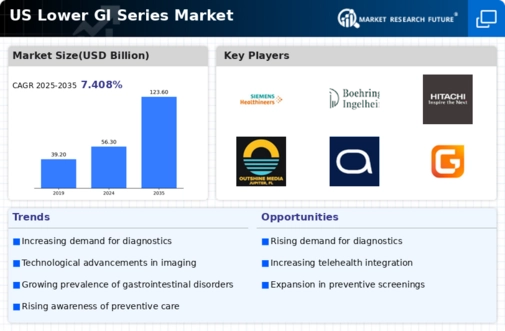Rising Healthcare Expenditure
The increase in healthcare expenditure in the US is another significant driver for the lower gi-series market. With healthcare spending projected to reach approximately $6 trillion by 2027, there is a growing investment in diagnostic services, including lower gi-series procedures. This financial commitment from both public and private sectors is likely to enhance the availability and quality of gastrointestinal diagnostics. The lower gi-series market stands to benefit from this trend, as increased funding can lead to improved facilities, better-trained personnel, and more comprehensive patient care options, ultimately driving market growth.
Advancements in Diagnostic Technologies
Technological innovations in diagnostic imaging are significantly influencing the lower gi-series market. Enhanced imaging techniques, such as high-definition endoscopy and advanced fluoroscopy, have improved the accuracy and efficiency of lower gastrointestinal examinations. These advancements not only facilitate better visualization of the intestinal tract but also reduce patient discomfort and procedure time. The lower gi-series market is experiencing a shift towards these modern technologies, which are expected to enhance diagnostic capabilities and patient throughput. As a result, healthcare facilities are increasingly investing in state-of-the-art equipment, further driving market growth.
Growing Demand for Preventive Healthcare
The shift towards preventive healthcare is a notable trend impacting the lower gi-series market. As awareness of the importance of early detection of gastrointestinal issues increases, more individuals are opting for routine screenings. This trend is particularly evident among the aging population, which is more susceptible to digestive disorders. The lower gi-series market is likely to see a surge in demand as healthcare providers recommend these procedures as part of comprehensive health assessments. Furthermore, the integration of preventive measures into healthcare policies may lead to increased insurance coverage for lower gi-series tests, making them more accessible to the general population.
Increasing Prevalence of Digestive Disorders
The rising incidence of digestive disorders in the US is a primary driver for the lower gi-series market. Conditions such as irritable bowel syndrome (IBS) and inflammatory bowel disease (IBD) have seen a notable increase, with estimates suggesting that around 15-20% of the population may experience IBS at some point in their lives. This growing prevalence necessitates advanced diagnostic tools, thereby propelling demand for lower gi-series procedures. As healthcare providers seek to improve patient outcomes, the lower gi-series market is likely to benefit from increased utilization of these diagnostic methods, which are essential for accurate assessment and management of gastrointestinal conditions.
Regulatory Support for Diagnostic Procedures
Regulatory bodies in the US are increasingly supporting the development and implementation of advanced diagnostic procedures, which positively impacts the lower gi-series market. Initiatives aimed at improving patient safety and diagnostic accuracy are encouraging healthcare providers to adopt lower gi-series tests. The lower gi-series market is likely to experience growth as regulations evolve to facilitate the integration of innovative technologies and methodologies. This regulatory support not only enhances the credibility of lower gi-series procedures but also fosters an environment conducive to research and development, further propelling market expansion.




















Leave a Comment